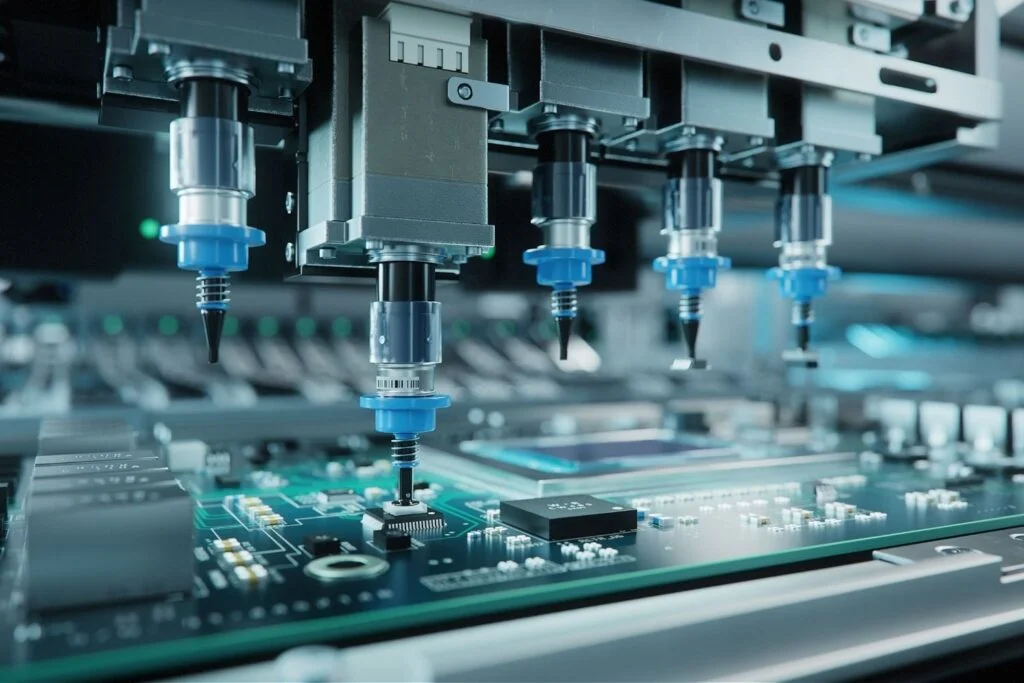In the world of printed circuit board assembly (PCBA), Surface Mount Technology (SMT) plays a critical role in producing high-quality, reliable electronic devices. SMT lines, the automated assembly lines used for mounting components onto printed circuit boards (PCBs), are at the heart of modern electronics manufacturing. This article provides an overview of SMT lines, their key components, processes, and significance in the PCBA industry.
What Are SMT Lines?
SMT lines are fully automated production lines designed to assemble electronic components directly onto the surface of PCBs. Unlike traditional through-hole technology, SMT does not require drilling holes into the PCB, enabling more compact and lightweight designs.
Key Components of an SMT Line
An SMT line typically consists of the following equipment and stations:
1. Solder Paste Printer
The process begins with the application of solder paste onto the PCB using a stencil. This ensures precise placement of solder in preparation for component mounting.
2. Pick-and-Place Machine
This machine is responsible for accurately placing components on the PCB. Using high-speed cameras and advanced robotics, it ensures precise alignment and positioning.
3. Reflow Oven
After component placement, the PCB moves through a reflow oven. The solder paste melts and solidifies during the heating and cooling stages, creating strong electrical and mechanical bonds.
4. Automated Optical Inspection (AOI) System
AOI systems inspect the assembled PCBs to detect any defects in soldering or component placement. This ensures high-quality production.
5. Conveyor System
The conveyor connects the various stages of the SMT line, ensuring smooth and efficient movement of PCBs.
The SMT Process in PCBA
1. Solder Paste Application
A solder paste printer applies solder paste to the PCB pads. Precision in this step is crucial for ensuring proper electrical connections.
2. Component Placement
The pick-and-place machine accurately places surface-mount devices (SMDs) onto the PCB based on the design layout.
3. Soldering (Reflow Process)
The PCB is heated in the reflow oven, where the solder paste melts, bonding components to the PCB. Controlled cooling solidifies the connections.
4. Inspection and Testing
AOI and other testing methods verify the functionality and quality of the assembled PCB, ensuring it meets design specifications.
Advantages of SMT Lines in PCBA
1. High Efficiency and Speed
SMT lines can produce large volumes of PCBs in a short time with high precision.
2. Compact Design
SMT allows for the placement of smaller components, enabling the creation of compact and lightweight devices.
3. Cost-Effectiveness
Automated SMT lines reduce labor costs and material waste, making the process more economical.
4. Improved Reliability
The precision of SMT lines ensures strong connections and reduced defects, resulting in higher reliability for the final products.
Applications of SMT Lines
SMT lines are essential in the production of various electronic devices, including:
• Consumer electronics (smartphones, laptops, wearables)
• Automotive electronics (ECUs, sensors, infotainment systems)
• Industrial control systems
• Medical devices
• Telecommunications equipment
Future Trends in SMT Lines
As the PCBA industry evolves, SMT lines are advancing to meet the demands of emerging technologies. Key trends include:
• Integration with AI and IoT: Real-time monitoring and optimization of SMT lines using AI and IoT technologies.
• Miniaturization of Components: SMT lines are adapting to handle smaller and more complex components.
• Environmentally Friendly Practices: The industry is moving toward greener manufacturing practices with lead-free soldering and energy-efficient equipment.
Conclusion
SMT lines are the backbone of modern PCBA manufacturing, enabling efficient, precise, and cost-effective production of electronic devices. As technology continues to evolve, SMT lines are becoming smarter, faster, and more adaptable to meet the ever-growing demands of the electronics industry. For companies in the PCBA sector, investing in advanced SMT lines is essential for maintaining competitiveness and delivering high-quality products to the market.







